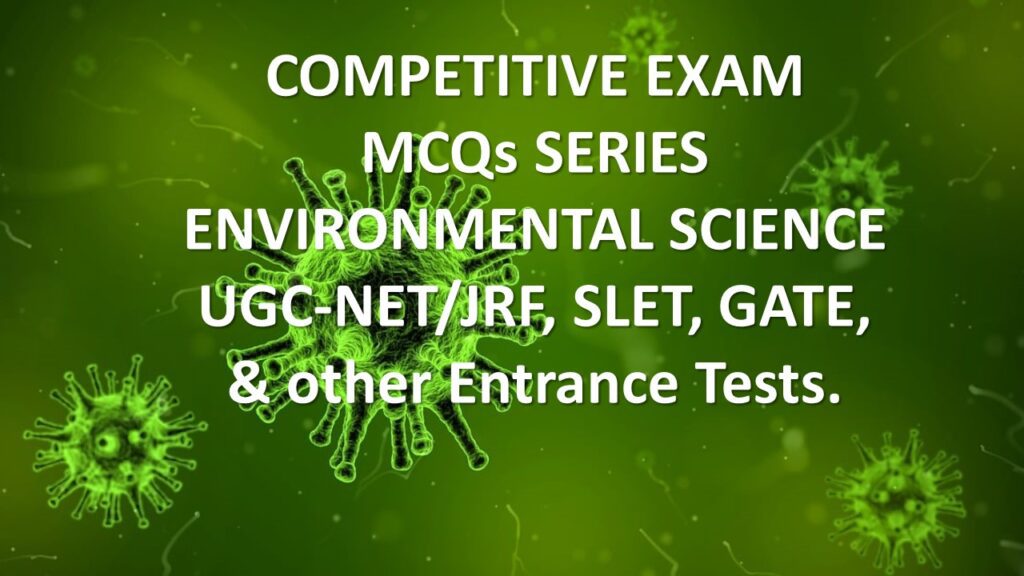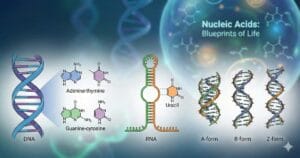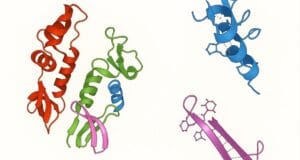
COMPETITIVE EXAM MCQs SERIES of ENVIRONMENTAL SCIENCE for UGC-NET/JRF, SLET, GATE, and other entrance tests – Environmental Biology – Environmental Biotechnology.
Syllabus outline
- Definition, scope, historical developments, and milestones of environmental biotechnology.
- Microbial communities in different ecosystems and the role of microorganisms in biogeochemical cycles (e.g., carbon, nitrogen, phosphorus).
- Biodegradation and bioremediation techniques for cleaning contaminated sites.
- Microbial processes for bioconversion of organic waste into bioenergy (e.g., biogas, bioethanol).
- Environmental implications and sustainability of bioenergy production.
- Microbial biosensors for environmental monitoring and detection of pollutants and environmental parameters.
- Microbial processes and biotechnological approaches for wastewater treatment.
- Applications of bioreactors and biofiltration in water purification.
- Microbial methods for air pollution control (e.g., biodegradation of volatile organic compounds, biofiltration, and bioreactors).
- Use of plants and microorganisms for phytoremediation of contaminated soils.
- Biotechnological strategies to enhance phytoremediation efficiency.
- Biodegradation and composting of organic solid waste.
- Microbial strategies for managing hazardous and non-biodegradable waste.
- Role of biotechnology in climate change mitigation and carbon sequestration.
- Biotechnological solutions for adapting to climate change impacts.
This quiz contains the concept-based most frequently asked 25 MCQs of “Environmental Biology – Environmental Biotechnology“. Each question has a single correct/most appropriate answer.
*****
1. What is the process of binding primer to the denatured strand?
a) Extraction
b) Annealing
c) Denaturation
d) Renaturation
2. ________ is a sequence of DNA that is the same when one strand is read from left to right or the other strand is read from right to left – consists of adjacent inverted repeats.
a) Intron
b) Palindromes
c) Exonucleases recognition sequences
d) Exon
3. How does biosurfactant overcome bioavailability issues in biodegradation processes?
a) It decreases viscosity
b) It decreases surface tension
c) It increases viscosity
d) It increases surface tension
4. What are the possible reasons for entry into a stationary phase of a typical microbial growth curve?
a) Nutrient limitation, Limited oxygen availability, Toxic waste accumulation, and Critical population density reached
b) Aging of microbial cells, Nutrient limitation, Limited oxygen availability, and Toxic waste accumulation.
c) Aging of microbial cells, Toxic waste accumulation, and Critical population density reached
d) Nutrient limitation, Limited oxygen availability, inter-specific competition, and Critical population density reached
5. Reverse transcription PCR uses:
a) ssDNA as a template to form mRNA
b) RNA as a template to form RNA
c) mRNA as a template to form cDNA
d) DNA as a template to form ssDNA
6. Why bioluminescence-producing reporter gene (lux) is cloned in biodegrading microorganisms?
a) It facilitates the selection of biodegrading microorganisms
b) It facilitates real-time monitoring of the bioremediation processes
c) It inhibits the biodegradation processes
d) It accelerates the biodegradation processes by the production of biosurfactant
7. In electrophoresis, DNA will migrate towards
a) The cathode or negative electrode
b) The anode or negative electrode
c) The anode or positive electrode
d) The cathode or positive electrode
8. Which of the following indirect methods is most commonly used in microbiology to monitor microbial growth?
a) Turbidity measurement
b) Membrane filtration
c) Viable plate counts
d) Microscopic counts
9. In the stationary phase of the microbial growth curve:
a) No correlation exists between death rate and the growth rate
b) The growth rate is equal to the death rate
c) The growth rate is lesser than the death rate
d) The growth is proportional to the death
10. The movement of DNA in an electric field depends on
a) The magnitude of charge and mass of DNA molecules
b) The magnitude of charge, shape, and mass of DNA molecules
c) Shape and size of DNA molecules
d) The magnitude of charge and shape of DNA molecules
11. Primers used for the DNA amplification process in the polymerase chain reaction are:
a) Single-stranded DNA oligonucleotide
b) Single-stranded RNA oligonucleotide
c) Double-stranded DNA oligonucleotide
d) Double-stranded RNA oligonucleotide
12. Crown gall disease in plants is caused by:
a) Agrobacterium faciens
b) Agrobacterium tumifaciens
c) Agrobacterium plantum
d) Agrobacterium niger
13. Why doubling time of microorganisms are longer in natural conditions than those obtained in laboratory culture?
a) Microbial cells are more susceptible to a solid substrate like agar media used in the laboratory
b) Due to intense intra-specific competition for a given organism in nature
c) Ideal growth conditions for a given organism may exist only intermittently in nature
d) Due to the presence of inhibitory and toxic substrates for a given organism in nature
14. Insertion of cry gene in plant genome provides:
a) Drought resistance
b) Herbicide resistance
c) Insect resistance
d) Virus resistance
15. NAH plasmid of “Superbug” is responsible for the degradation of:
a) Naphthalene
b) Octane
c) Camphor
d) Xylene
16. Which reagent is commonly used for bacterial cell wall lysis?
a) Phenol Extraction
b) Lysozyme
c) Penicillin
d) CTAB
17. Genetically engineered microbe is required to degrade recalcitrant xenobiotic compounds present in the environment because:
a) Most often a single microorganism is not able to degrade xenobiotic compounds present in the environment
b) Xenobiotic compounds can hinder the growth of microorganisms and pose challenges regarding their bioavailability.
c) A consortium of enzymes required for degradation, microbial toxicity, and bioavailability of xenobiotic compounds
d) High cost of bioremediation processes and difficulty in monitoring the efficiency of treatment
18. Organisms that have a gene or genetic construct of interest introduced via molecular or recombinant DNA techniques are referred to as:
a) Superbug
b) Transgenic
c) Wild
d) Hybrid
19. Which of the following is true for asymmetric PCR?
a) Used for generating single-stranded copies of DNA template
b) Used for generating hybridized copies of DNA template
c) Used for generating cDNA from mRNA template
d) Used for generating double-stranded copies of DNA template
20. The technique used to identify specific DNA sequences in bacterial colonies is
a) Southern blotting
b) Dot blot techniques
c) Colony hybridization
d) In situ hybridization
21. What is the key role of EDTA (Ethylene diamine tetra-acetic acid) in nucleic acid isolation?
a) It catalyzes the breakdown of the peptidoglycan layer of the cell wall.
b) It helps in the removal of lipid molecules and denaturation of membrane proteins.
c) It inhibits the cellular enzymes that degrade nucleic acid and destabilize the integrity of the cell wall.
d) It inhibits the cellular enzymes that degrade nucleic acid and destabilize the integrity of the cell wall and also helps in the removal of lipid molecules
22. The metabolic rate of individual microbial cells is at a minimum during:
a) lag phase
b) log phase
c) Stationery phase
d) Exponential phase
23. Which of the following statements is not correct for the PCR?
a) Automated PCR machines are called thermal cyclers
b) A thermostable DNA polymerase is required
c) Millions to billions of desired DNA copies can be produced from microgram quantities of DNA
d) Double-stranded DNA oligonucleotides are required as a primer for the amplification of template DNA
24. What is the correct complementary DNA strand of a DNA strand 5′ – TACCGATTAAT – 3′?
a) 3’ – ATGGCTAATTA – 5’
b) 3’ – AUGGCUAAUUA 5’
c) 5’ – ATGGCTAATTA – 3’
d) 3’- TACCGATTAAT – 5’
25. Southern Hybridization is used to identify:
a) A specific protein
b) A specific RNA
c) A specific DNA
d) Both DNA and RNA
*****
Previous: Concept of Industrial Ecology
Next: Origin of Earth
References
- Singh, R. B., and Sinha, R. K. (2017) Environmental Science: Earth as a Living Planet, Khanna Publishers, 1st edition.
- Sharma, P. D., and Jha, R. (2017) Environmental Biology, Rastogi Publications, 1st edition.
- Tyagi, R. D., and Khan, Javed Ali (2014) Environmental Biotechnology: Principles and Applications, McGraw Hill Education, 1st edition.

